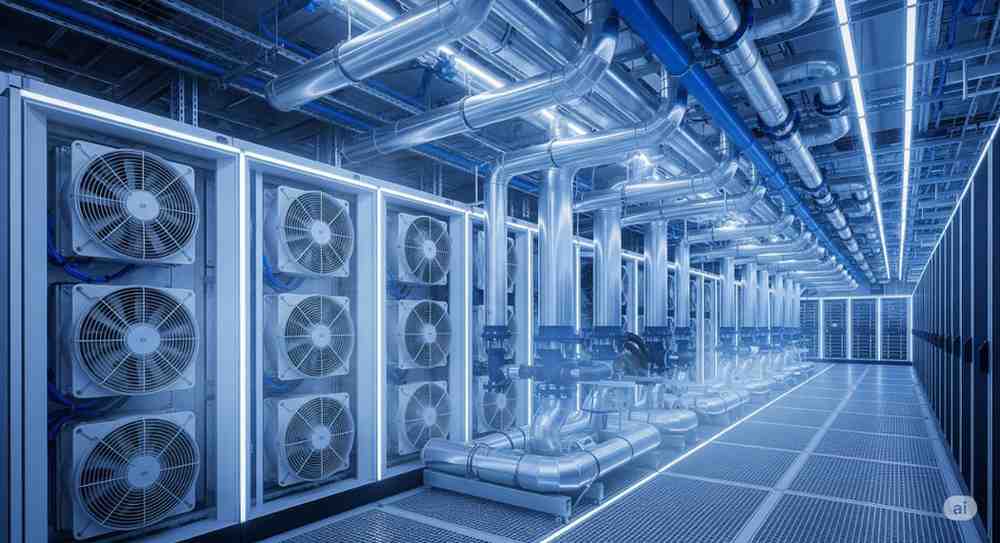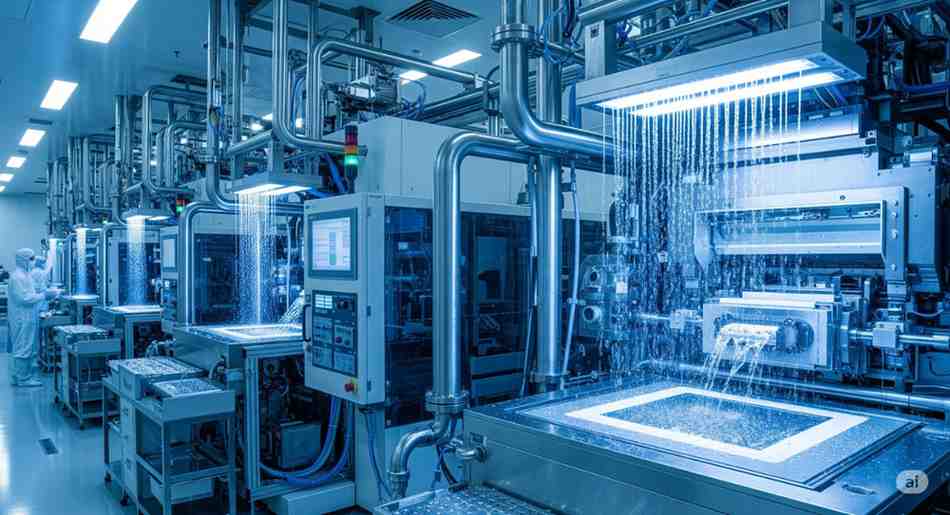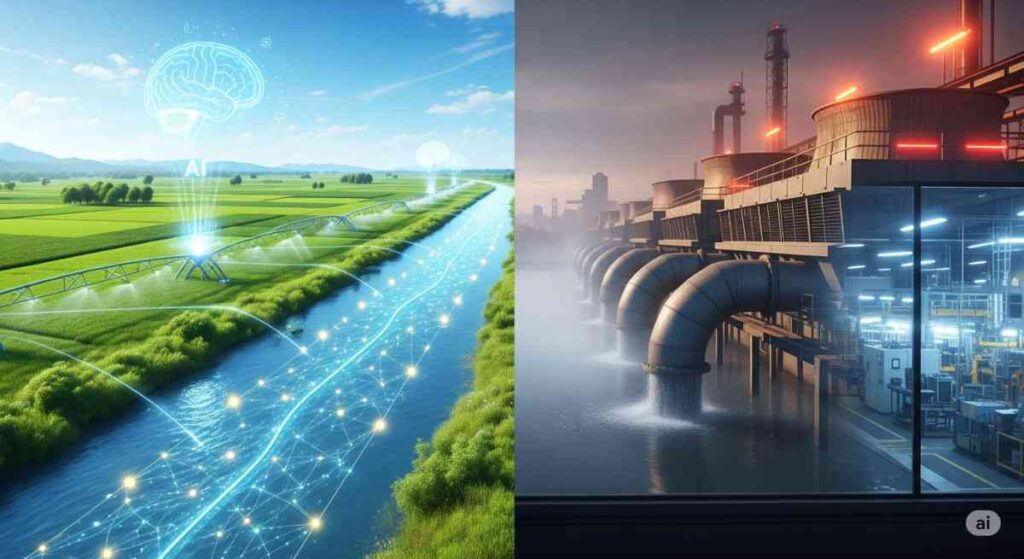Artificial intelligence is changing our world. We see AI everywhere, from helpful chatbots to amazing image generators. This technology transforms industries. It helps us solve hard problems and makes daily life easier. Many people wonder what AI can do next.
But there is a hidden cost to this powerful technology. AI demands huge amounts of freshwater. While AI feels like something you can’t touch, its machines and operations need real resources. This thirst for water often goes unnoticed.
This article pulls back the curtain. We will explore how AI uses freshwater. You’ll see the scale of this use and what it means for our planet. We also look at smart ways to reduce AI’s environmental impact.
The Data Center’s Thirst: Cooling AI’s Infrastructure
AI systems need big computer centers to run. These places are called data centers. They get very hot when they work. To keep cool, data centers use a lot of water.

Data Center Cooling Mechanisms
Keeping servers from overheating is key. Data centers use special cooling systems. Many of these rely on water.
Evaporative Cooling: This method uses water to remove heat. Water turns into vapor, taking heat with it. Some systems spray water directly into the air. Others pass air over wet pads. This process uses water constantly.
Water-Cooled Chillers: Chillers work like giant refrigerators. They cool water, which then flows through pipes to absorb heat from the air. This hot water often goes to cooling towers. There, some water evaporates to release heat. The cooled water then returns to the chiller.
AI’s Growing Footprint
The world wants more AI. This means we need more data centers. AI’s demands are making these centers grow fast.
AI Model Training: Building new AI models, like big language tools, takes immense power. These models need many computers working non-stop. This creates a lot of heat. More training means bigger, hotter data centers.
AI Inference: It’s not just training. Using AI for daily tasks, like asking a chatbot a question, also needs processing. This constant use means data centers run all the time. They need continuous cooling.
Geographic Concentration: Many data centers are built in places with mild weather. They also need easy access to water. This can put a lot of stress on local water supplies. Sometimes, these areas already face water shortages.
Water Consumption Metrics and Examples
How much water do data centers really use? Experts track this with special numbers.
Water Usage Effectiveness (WUE): WUE is a way to measure how efficient a data center is with water. A lower WUE score means less water is wasted. It helps companies track their water footprint.
Industry Reports/Studies: Many groups study data center water use. Reports show that this consumption is on the rise. Some studies suggest large data centers can use millions of gallons of water each day. This is a huge amount.
Case Studies: Think about big tech companies. Their data centers are often massive. They might be in dry regions. This can cause problems for local communities needing water. Their thirsty operations compete for a limited resource.
The Manufacturing Pipeline: Building AI Hardware
Before AI can even run, we need its parts. The tiny computer chips that power AI need huge amounts of water to be made. This part of AI’s water use is often overlooked.

Semiconductor Fabrication
AI runs on special chips, like GPUs. Making these chips is a very complex process. It uses a lot of water.
Wafer Production: Chips start as thin slices of silicon, called wafers. These wafers go through many steps. Each step cleans, shapes, and layers tiny circuits. It’s a delicate dance of chemistry and physics.
Rinsing and Cleaning: Throughout the process, workers must clean the wafers often. Even a tiny speck of dust can ruin a chip. So, they rinse the wafers over and over. This cleaning uses vast amounts of ultra-pure water.
Water Quality Requirements
The water used to make chips isn’t just tap water. It must be super clean.
Ultra-Pure Water (UPW): This water is cleaner than distilled water. It goes through many filters. All minerals and particles are removed. It’s so pure, it’s almost empty. Making UPW itself needs a lot of energy and water.
Contaminant Sensitivity: Why such pure water? Chip parts are incredibly small. Even a tiny bit of impurity can break a chip. So, factories must use UPW for flawless cleaning. This ensures the chips work right.
Water Footprint of Chip Production
The water needed for one chip might surprise you.
Water per Chip/Wafer: Making a single semiconductor wafer can take thousands of gallons of water. This adds up fast. Each AI chip, though small, carries a big water footprint from its birth.
AI in Water Management: A Double-Edged Sword
It’s a bit ironic. AI itself can help us manage water better. But making and running AI systems also uses more water. Let’s look at both sides.

AI for Water Efficiency
AI can be a great tool for saving water. It can make systems smarter and more efficient.
Smart Grids and Leak Detection: AI can watch water pipes. It finds leaks quickly. This helps cities fix problems fast. It saves millions of gallons of water each year. AI can also make sure water goes where it’s needed most.
Precision Agriculture: Farmers can use AI to water crops. Sensors tell AI exactly when and how much water plants need. This cuts down on wasted water. It helps farmers grow more with less.
Wastewater Treatment Optimization: AI can make water treatment plants run better. It helps them clean water more efficiently. This means less energy used. It also helps reuse water safely.
Unintended Consequences of AI Deployment
While AI can help, its widespread use might also create new water demands.
Increased Demand for Services: If AI makes farming easier, farmers might grow more crops. This could mean more overall water use, even if each crop is more efficient. AI might make other water-heavy industries grow too.
Edge Computing and Local Data Centers: We are seeing more small data centers closer to where people live. These “edge” centers handle data faster. While good for speed, they still need cooling. Many small centers could mean more water use spread out across more places. This could strain local water supplies.
Mitigating AI’s Water Footprint: Towards Sustainable AI
We can develop AI without draining our planet’s freshwater. It needs smart choices and new ideas.
Improving Data Center Efficiency
Data centers can cut down on their water use. New tech helps them stay cool with less water.
Advanced Cooling Technologies: Instead of evaporating water, some systems use liquid directly. This “liquid cooling” is very efficient. Other centers use cold outside air to cool servers. They also capture heat to warm buildings nearby.
Water-Efficient Design: Where a data center is built matters. New centers can use recycled water. They might use ocean water if available and treated well. Closed-loop cooling systems also reuse water over and over.
Renewable Energy Integration: Powering data centers with clean energy helps indirectly. Many power plants use a lot of water for cooling. Using wind or solar power means less water for electricity production.
Greener Semiconductor Manufacturing
Chip makers are finding ways to use less water. This is vital for AI’s future.
Recycling and Reuse: Chip factories can clean and reuse water. Special systems filter water many times. This drastically cuts down on fresh water needed for rinsing.
Dry Etching and Other Waterless Processes: Scientists are working on ways to make chips without water. They are exploring new chemicals or gas-based methods. These innovations could be game-changers for water saving.
Responsible Siting: New chip factories should be built in places with plenty of water. They should also have strong rules about water use. This prevents stress on local water sources.
Policy and Corporate Responsibility
Governments and companies must work together. They can make AI more water-friendly.
Water Disclosure and Reporting: Companies should share how much water they use. This helps everyone see the problem. Transparency can encourage better practices.
Incentivizing Efficiency: Governments can give tax breaks or grants. This would help companies invest in water-saving tech. Rules can also set limits on how much water can be used.
Water Disclosure and Reporting: Companies should share how much water they use. This helps everyone see the problem. Transparency can encourage better practices.
Conclusion
AI is amazing, but it has a hidden thirst. From the vast data centers that power AI to the tiny chips that make it work, freshwater is consumed at every step. This use is significant. It links AI’s growth directly to our global water resources.
We have seen the different ways AI uses water. We also explored how AI can help save water. Still, the overall demand for water by AI is a big concern. It’s a challenge we must face head-on.
It’s time for conscious design and smart practices. We need new tech and strong policies. This will make sure AI helps humanity without harming our planet’s precious water. Let’s work to build an AI future that is both smart and sustainable.

